Written by: Sijia SunArticle No. 38 [UNCTAD Transport and Trade Facilitation Newsletter N°83 - Third Quarter 2019]
“There is no best business environment, only better. China will continue to make efforts on optimizing the business environment at ports and improving the facilitation of customs clearance” Deputy Director of the General Administration of Customs of China (2019).
The People’s Republic of China ratified the WTO Trade Facilitation Agreement (TFA) on 4 September 2015. On 27 March 2016, the China State Council set up China’s National Trade Facilitation Committee as an Inter-Ministerial Coordination Mechanism for Trade Facilitation. The Ministry of Commerce leads this mechanism, which encompasses 16 Ministries.
This article explores:
How has the Trade Facilitation environment evolved in China since 2015, using internationally recognized indicators, scores and rankings, published by UNCTAD, the World Bank Group, OECD and WTO.
Recent developments related to implementation of the 4 TFA provisions that China will implement by 22 February 2020.
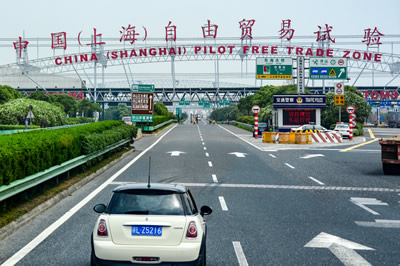
I. The status of China’s implementation of the TFA
China has notified all measures of the TFA. China classified 4 provisions, mentioned in table 1, as Category B (i.e. designated for implementation on a date after a transitional period, following the entry into force of the TFA). The definitive date of implementation of these provisions is 22 February 2020. By this date, China will implement all measures foreseen in the TFA, through its own means and efforts.
Table 1: Notification of China’s commitments under Category B of the TFA
Provision: | What is this provision about? |
Article 7.6 | Establishment and Publication of Average Release Times (Members shall measure and publish their average release time of goods periodically and in a consist manner) |
Article 10.4 | Single Window (A single-entry point enabling traders to submit at once all documentations and data required for importation, exportation, or transit of goods) |
Article 12.2 | Exchange of Information (Customs of Members shall cooperate to exchange relevant information for verifying an import or export declaration where there are reasonable grounds to doubt its truth and accuracy) |
Article 12.6.1 | Provision of Information (Specifies contents, means, time limit, etc. for the provision of information that may be requested in connection with article 12.2) |
Source: WTO (2018). Notification of category commitments under the TFA: Communication from China. Document G/TFA/N/CHN/1/Add. 2 dated 14/02/2018
II. Assessing the evolution and current situation of Trade Facilitation in China using different indicators
Indicator 1: World Bank Doing Business – Trade Across Borders Ranking
Between 2016 and 2018, China’s score of Trade Across Borders was stagnant at 69.91. In 2019, China was ranked 65 out of 190 countries, with a score is 82.59, entailing a significant improvement. The table below shows how China has improved on Trade Across Borders from 2018 to 2019.
Table 2: China’s improvement from 2018 to 2019 on the time and cost of exporting & importing goods
China | 2018 | 2019 |
Time to export: Border compliance | 25.9 hours | 25.9 hours |
Time to export: Documentary compliance | 21.2 hours | 8.6 hours |
Time to import: Border compliance | 92.3 hours | 48 hours |
Time to import: Documentary compliance | 65.7 hours | 24 hours |
Cost to export: Border compliance | 484.1 USD | 314 USD |
Cost to export: Documentary compliance | 84.6 USD | 73.6 USD |
Cost to import: Border compliance | 745 USD | 326 USD |
Cost to import: Documentary compliance | 170.9 USD | 122.3 USD |
Source: World Bank, “Doing Business: Measuring Business Regulations”: Historical Data Sets and Trends Data
Indicator 2: World Bank’s Logistics Performance Index (LPI)
According to the LPI, China improved from position 30 in 2007 to 26 in 2018 among the 160 countries. All six indicators have progressed during these years, with the most evident improvement observed in the quality of trade and transport related infrastructure, which increased by 0.55 points from 2007 to 2018.
Figure 1: The Evolution of China in World Bank’s LPI
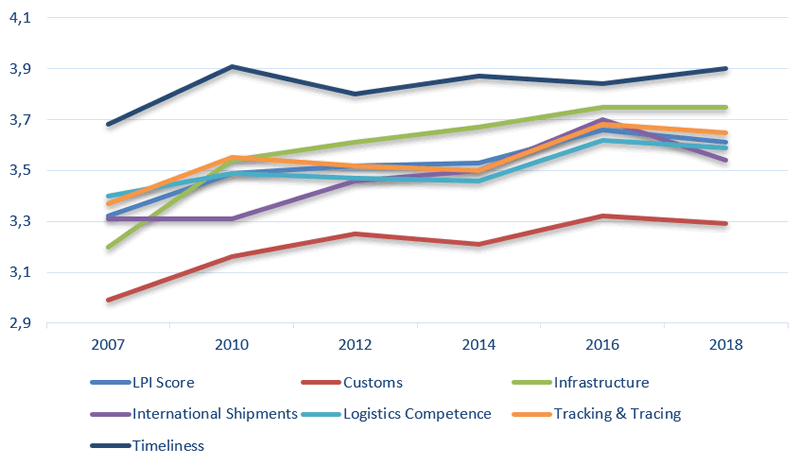
Source: World Bank, LPI Country Score Card: China 2018
Compared with the best performing country globally (Germany) and the best performing country in the East Asia and Pacific Region (Japan), there is still room for improvement for China on the six aspects of the LPI and specially in relation to the efficiency of the clearance process by border control agencies, including customs.
Figure 2: Comparison between China and the best global and regional logistic performance
(China 2018)
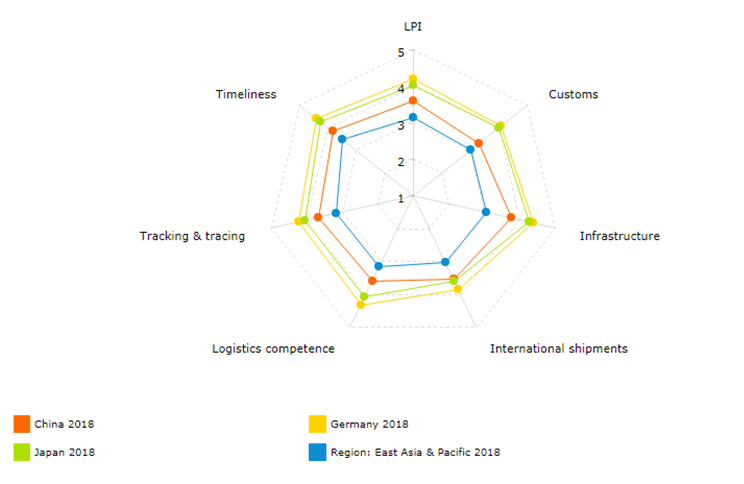

Source: World Bank LPI Country Scorecard: China 2018
Indicator 3: UNCTAD Liner Shipping Connectivity Index (LSCI) and Port Liner Shipping Connectivity Index (PLSCI)
The UNCTAD’s LSCI and PLSCI have the same aim as the LPI, and they both provide information about countries’ trade competitiveness in the area of transport and logistics though in different ways. According to UNCTAD’s LSCI for 2019, China has retained its lead as the country best connected to others by sea. The country’s LSCI has increased by 51% since 2006. Specifically, according to the PLSCI for 2019, the Shanghai port has topped the ranking of the world’s best-connected ports which garnered a connectivity score of 134.32 points. The Ningbo port doubled its PLSCI since 2006, and it has had the highest absolute PLSCI growth of all ports in the world. Undoubtedly, the high port efficiency is important for promoting trade facilitation.
Figure 3: China has been the lead of the LSCI ranking, 2006-2019
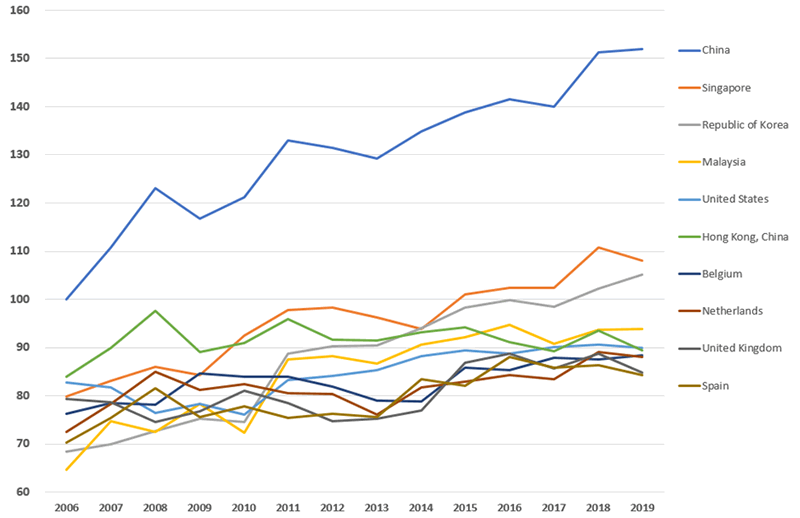
Source: UNCTAD, Liner Shipping Connectivity: top 10 countries, 2006-2019
Indicator 4: OECD Trade Facilitation Indicators (TFIs)
Between 2015 and 2017, China’s performance, measured through the TFIs, improved in the areas of information availability, appeal procedures, documentation requirements, and governance and impartiality. Performance in dimensions of advance rulings, fees and charges, automation of border procedures, streamlining of border processes, domestic border agency cooperation, and cross-border agency cooperation remained stable, whereas the indicator of trade community involvement regressed. The specific reasons for the regression are unclear. Probably, a more active participation of the private sector in the activities of China National Trade Facilitation Committee, could help improve performance under this indicator.
Figure 4: The Evolution of China in OECD TFIs
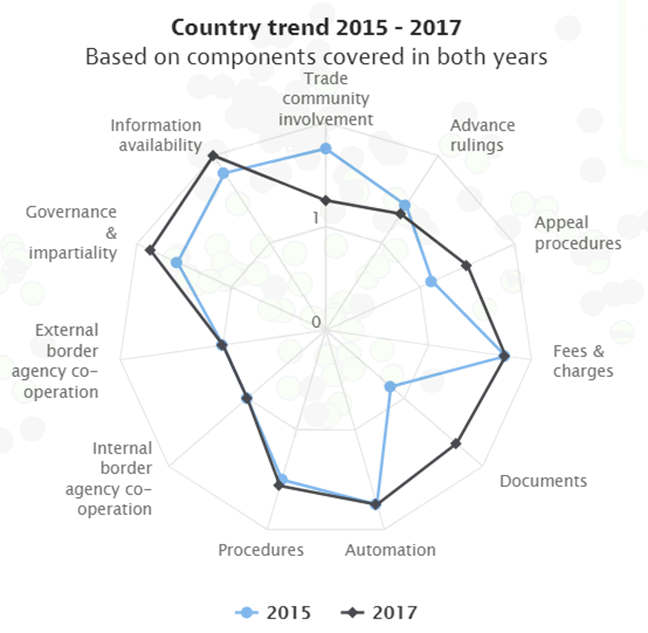
Source: OECD Trade Facilitation Indicators (TFIs) / Compare your country database
China exceeds the average performance of upper middle-income countries in all TFIs areas and is close to the best performers in terms of information availability, advanced rulings, and fees and charges.
Figure 5: Comparison between China and the best practice on OECD TFIs
Country performance, latest available year
2 = best performance that can be achieved
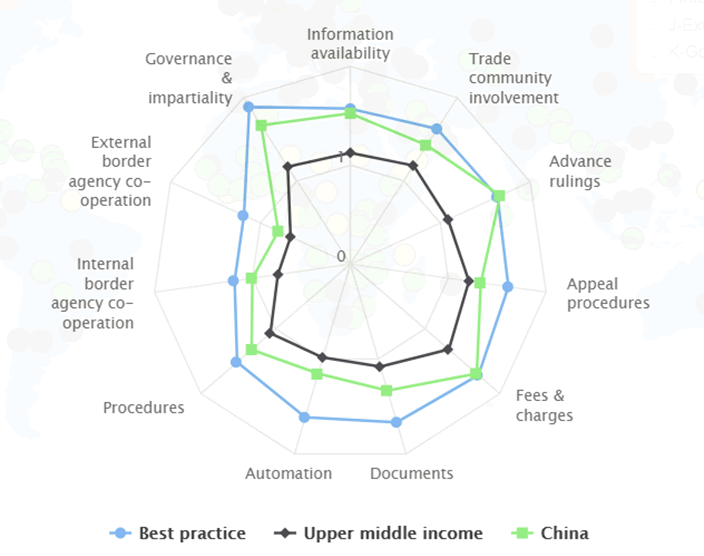
Source: OECD Trade Facilitation Indicators (TFIs) / Compare your country database
In 2018-2019, China reduced the time and cost to export and import by implementing a single window, eliminating administrative charges, increasing transparency and encouraging competition. In addition, China has been working hard to improve trade facilitation through formulating and upgrading the relevant supporting system, strengthening trade and transportation related infrastructure, simplifying customs clearance procedures and raising customs clearance efficiency, etc. Meantime, efforts on promoting the involvement of the trade community and enhancing consultations with private sectors should be further encouraged in the future.
III. Recent developments
China has recently launched a new initiative to speed up customs clearance and optimize the business environment at ports (Notice on Accelerating the Level of Customs Clearance Facilitation, jointly issued by the General Administration of Customs, the Ministry of Finance, the Ministry of Commerce and other 7 Ministries of China). 10 specific measures have been proposed including simplifying documents, optimizing processes, improving automation, and reducing charges. Figure 5 explains the scope of these measures, as well as its correspondence with provisions in the TFA.
Figure 6: Highlights from the newly issued Notice and relation with TFA provisions
Simplifying documents
86 documents have been reduced to 46 in 2018, and two more food-related documents will be withdrawn from port inspection before 30 Sep 2019.
Import and export regulatory documents will fully implement online declaration and processing by the end of 2019, except in the case of special circumstances such as those involving confidentiality and security considerations.

Article 10
Formalities related to importation, exportation and transit
Optimizing processes
Before 31 Aug 2019, a pilot simplified import declaration will be launched. It involves a summarized “two-step declaration” customs clearance mode.
Before the end of 2019, the port administration will formulate and make public the time limit standards for the operation of port service enterprises.
Two “green channels” for the rapid clearance of agricultural products will be opened.

Article 7
Release and clearance of goods
Improving automation
The single window platform enabled information sharing between 25 Ministries and running online cooperation projects between 68 departments, covering all ports in the country and meeting the requirements of business for a "one-stop" operation.
China will deepen the building of the single window for international trade, reinforcing the cooperation with financial institutions and transportation agencies, and strengthening international information exchange.

Article 10.4
Single window, Article 8 Border agency cooperation, and Article 12 Customs cooperation
Reducing charges
Port administrative departments have actively promoted the publication of fees, reduced charge items, and lowered the rates for some government pricing and government-guided price of port administrative fees since 2018. For example, since 1st Apr 2019, the rates of cargo port fees and port facilities security fees were lowered by 15% and 20% respectively.
China has also encouraged relevant business service companies to reduce fees. A special inspection will be launched before the end of Sep 2019.

Article 6
Disciplines on fees and charges imposed on or in connection with importation and exportation and penalties
These measures show China’s commitment to deepen trade facilitation reforms and to implement the obligations of the TFA. Undeniably, these will be helpful for promoting trade across borders.
Sijia Sun is Junior Professional Officer at UNCTAD Trade Facilitation Section. Contact: sijia.sun@un.org



